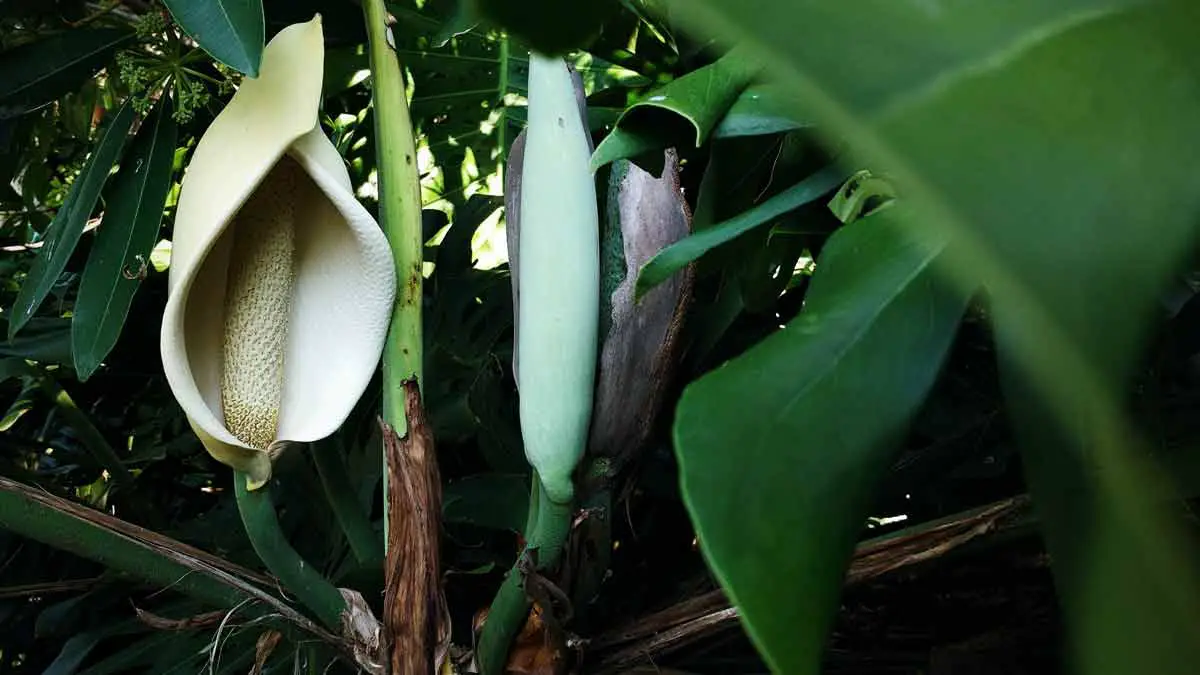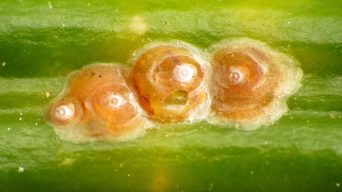Monstera plants can produce white flowers with a spadix in their natural habitat or similar conditions. Flowering and fruiting are rare indoors but can occur if the plant is mature and well-cared for. It may take up to three years for a Monstera to flower under ideal conditions.
Monstera plants, known as the Swiss Cheese plant due to their distinctive holey leaves, have captivated the hearts of plant enthusiasts worldwide.
These fascinating evergreen vines boast stunning foliage and produce flowers and delectable fruit.
But do monstera plants flower indoors? The answer might surprise you!
Dive in to learn about monstera plant flowering habits, how to encourage blossoms in your home, and even discover how to grow delectable fruits from these beautiful plants.
Understanding Monstera Plant Flowering
Monstera plants are popular for their striking foliage. Still, they also have the potential to bloom during the spring and summer months.
Several factors, including age, health, nutrition, and environmental conditions, can affect the flowering patterns of these plants.
Understanding these factors can help plant enthusiasts encourage blooming and ensure the plant’s health.
Here we will explore the various factors that influence the flowering of Monstera plants.
The Blooming Season
The blooming season of Monstera plants is a topic surrounded by intrigue and curiosity, mainly because these exotic beauties rarely flower indoors.
In their natural habitat, Monstera flowers have no specific blooming time or season, making it even more fascinating when they eventually showcase their stunning blooms.
This lack of a fixed schedule results from the unique growing conditions in the wild where Monsteras thrive.
Understanding what influences the appearance of Monstera flowers can shed light on how to coax them into flowering at home.
Humidity, temperature fluctuations, plant age, and species variations are vital in their blooming patterns.
For instance, well-established indoor Monstera Deliciosa plants tend to bloom and fruit simultaneously due to an extended period required for the inflorescence to transform into mature fruit.
Patience and deliberate care are crucial keys that may unlock your Swiss Cheese Plant’s charming secret – its elusive blossoms.
Factors That Affect Flowering
Monstera plants, especially the popular Monstera deliciosa variety, are known for their striking foliage and unique leaf patterns.
However, not all plant enthusiasts know these stunning specimens can flower under the right conditions.
When it comes to encouraging your Monstera to bloom, consider the following factors:
- Age and Maturity: Mature monstera plants are more likely to produce flowers than young ones, so give your plant time to grow before expecting blossoms.
- Light Conditions: Providing bright indirect light is essential for promoting flowering in monstera plants. Avoid direct sunlight as it can burn their leaves.
- Proper Nutrition: Good quality soil and consistent fertilization will encourage healthy foliage growth and increased chances of flowering.
- Adequate Watering: Ensuring the correct watering schedule helps prevent root rot while providing sufficient hydration for blooming.
- Temperature and Humidity: Monsteras prefer warm temperatures (around 68-86°F) and high humidity levels (60-80%) – keeping these conditions stable may increase the likelihood of flowers forming.
- Healthy Root System: Supporting a strong aerial root system with moss poles or other climbing structures aids overall plant health and can contribute to successful flowering.
- Monstera Variety: Certain monstera species are more prone to flowering than others; for example, Monstera deliciosa is more likely to flower indoors than Monstera adansonii or Monstera obliqua.
Types Of Monstera Flowers
Monstera flowers are not what you typically expect from a blooming plant.
They consist of an intriguing structure called an inflorescence. It features a fleshy erect spadix or spike covered with tiny blooms and surrounded by a boat-shaped spathe.
The coloration of the spathe is generally white or yellow and may have subtle tones of other colors.
The various types of Monstera plants offer different yet fascinating flower structures.
For instance, the popular Monstera deliciosa displays its creamy-white spathes while growing as an indoor plant.
It often reaches impressive sizes if provided with enough space to climb.
Meanwhile, Monstera adansonii, also known as Swiss cheese vine, showcases smaller but equally stunning floral displays that still captivate plant enthusiasts.
With nearly 50 species in the monstera family producing their unique blooms, these exotic plants continually capture our imaginations and hearts with their mysterious beauty.
Which Monstera Plants Produce Flowers?
Some Monstera plant varieties that produce flowers include Monstera deliciosa, Monstera adansonii, and Monstera lechleriana.
Overview Of Flowering Varieties
Monstera plants come in various varieties, each with unique characteristics and flowering habits.
Here’s an overview of some common varieties that produce flowers:
- Monstera Deliciosa: This is the most popular Monstera variety, known for its split leaves and aerial roots. It produces white flowers and can grow up to 60 feet tall in its natural habitat.
- Monstera Adansonii: The “Swiss Cheese Vine” has heart-shaped leaves with small holes and produces pink or white flowers.
- Monstera Obliqua: This rare variety is characterized by its delicate, paper-thin leaves that are almost see-through. It produces tiny white flowers but rarely blooms indoors.
- Monstera Lechleriana: This variety resembles the Deliciosa but has narrower leaves and a more compact growth habit. It produces small, white flowers but is also unlikely to bloom indoors.
- Other Varieties: Other less common varieties of Monstera plants that produce unique types of flowers include Monstera Borsigiana, Monstera Siltepecana, and Monstera Standleyana.
It’s essential to note that not all Monstera varieties produce flowers, so be sure to do your research before purchasing a specific plant for its blooming potential.
Differences In Flowering Habits
Monstera plants have different flowering habits depending on the species.
Some varieties, such as Monstera deliciosa and Monstera adansonii, produce large white flowers growing up to a foot long.
These types of monstera plants typically flower in late spring or early summer.
Other species of Monstera plants, like Monstera obliqua and Monstera lechleriana, have inflorescences (clusters of small flowers) that look pretty different from the large blooms produced by M. deliciosa and M. adansonii.
These varieties tend to flower less frequently than their larger-flowered counterparts.
It’s worth noting that some monstera plants may not flower at all, even if they meet all the necessary conditions for blooming.
Signs Your Monstera Plant Is Ready To Flower
Some signs can help you determine whether your plant is ready to bloom.
In addition to monitoring the plant’s health and growth, you should also pay attention to the presence of aerial roots.
But, the process is not always straightforward.
Here we’ll explore the signs your Monstera plant is ready to flower and provide tips to help you promote and encourage flowering.
1. Growth And Development
Monstera plants can grow quite fast, given the right conditions.
They require plenty of light and humidity to thrive. Still, overwatering or underwatering can cause issues like root rot or yellowing leaves.
Once established, Monstera plants can grow several feet annually on average, with their iconic fenestrated leaves becoming increasingly split as they mature.
When it comes to flowering, Monstera plants will typically produce an inflorescence in the summer months once they have reached a certain level of maturity.
This process can take several years to over a decade, depending on factors such as light intensity and plant health.
As the inflorescence develops, it will eventually unfurl into a large spathe that wraps around a central spadix covered in tiny flowers.
Once pollinated by insects or self-pollination occurs, these flowers will give way to edible fruit resembling miniature pineapples known as monstera deliciosa fruit – though not all species of Monstera can produce this fruit!
2. Presence Of Aerial Roots
One of the signs that your Monstera plant is ready to flower is the presence of aerial roots.
These roots grow above ground and can serve several purposes for the plant.
In addition to supporting climbing, aerial roots can absorb moisture and air nutrients.
You may notice these roots emerging from your Monstera’s stem or branches, especially if placed in a humid environment.
The plant is healthy and doing well if you see aerial roots on your Monstera.
The presence of these roots suggests that your Monstera has reached a certain level of maturity and is ready to start blooming.
However, not all varieties of Monstera produce aerial roots, so it’s important to know what type of plant you have before expecting them to appear.
Some examples include Monstera deliciosa, which typically produces numerous large leaves with holes called fenestration as they mature, or Monstera adansonii, characterized by its smaller heart-shaped leaves with more perforations.
As an indoor gardener or houseplant enthusiast, you can encourage your Monstera’s growth by providing adequate light (indirect sunlight or bright filtered light), creating a proper watering/fertilization schedule (avoid root rot), and maintaining optimal temperature and humidity levels.
3. Improved Health And Nutrition
As a Monstera plant enthusiast, you may wonder if flowering has any health benefits.
While there isn’t necessarily a direct link between improved health and nutrition and Monstera flower production, caring for these plants can positively affect mental well-being.
Studies have shown that interacting with indoor plants can reduce stress levels and improve mood.
In addition to their potential psychological benefits, Monstera plants offer air-purifying qualities that enhance overall physical health.
They remove harmful environmental toxins and release fresh oxygen into the air.
This makes them an ideal houseplant choice for promoting a healthy home environment.
While flowering may not directly affect your health and nutrition, incorporating Monstera plants into your living space can have mental and physical benefits.
With proper care, these unique plants will brighten up any room in more ways than one!
How To Encourage Monstera Plant Flowering
To encourage your Monstera plant to bloom, ensure it receives plenty of bright indirect light, proper watering, fertilization, and maintain optimal temperature and humidity levels.
But don’t stop here – there are more ways to help your plant produce flowers!
Provide Adequate Light
Monstera plants require adequate light for proper growth and flowering.
They do well in bright, indirect sunlight or filtered light.
It is best to avoid direct sunlight, which can damage the leaves and result in unsightly burns.
In summer, Monstera plants need around 6 hours of bright light, while during winter, they require more direct sun exposure.
One way to ensure your Monstera plant gets enough light is by placing it near a window that receives ample natural light.
You can also supplement with artificial lights if you don’t have access to natural sunlight.
The ideal temperature for Monstera plants ranges between 60°F – 85°F, which is excellent news as it overlaps with most indoor temperatures.
Providing adequate lighting not only helps produce beautiful flowers but also promotes healthy foliage growth, which contributes to the overall aesthetic appeal of your plant.
Remember, every plant has different needs, so adjust the lighting requirements based on what works best for your specific species of Monstera plant!
Proper Watering And Fertilization
Proper watering and fertilization are essential to encourage the Monstera plant to flower.
Here are some tips on how to achieve this:
1. Watering:
- Monstera plants prefer well-drained soil, so ensure the pot has drainage holes.
- Water the plant thoroughly until water drips out of the bottom of the pot.
- Allow the top inch of soil to dry out before watering again.
- During winter, water less frequently to avoid overwatering and root rot.
2. Fertilization:
- From spring until fall, fertilize your Monstera plant with a balanced liquid fertilizer every two weeks.
- Dilute the fertilizer to half its strength before application.
- Do not fertilize during winter when growth slows down.
3. Signs of improper watering and fertilization:
- Brown edges on leaves can indicate underwatering or overfertilization.
- Yellowing leaves may signify overwatering or lack of nutrients.
Maintain Optimal Temperature And Humidity
To encourage Monstera plant flowering, it’s essential to maintain optimal temperature and humidity levels.
These plants are naturally tropical and thrive in warm and humid conditions.
Ideally, the temperature should be between 68°F to 86°F, with a relative humidity of around 60-80%.
You can maintain these conditions by placing your plant in a room with bright indirect sunlight or investing in a humidifier if you live in an area with dry air.
You can also place a tray filled with pebbles and water under your Monstera’s pot to increase the surrounding moisture levels.
Remember that sudden changes in temperature or humidity can be stressful for your plant, so try to keep them as consistent as possible.
Monitor your Monstera’s leaves for signs of dehydration or overhydration – yellowing or curling leaves could indicate too little moisture. At the same time, brown spots might suggest too much water.
Providing adequate warmth and humidity will create the perfect environment for your Monstera plant to produce beautiful flowers and fruits!
Can Monstera Plants Produce Fruit?
Monstera plants are popular for indoor gardeners due to their striking appearance and low-maintenance nature.
One exciting aspect of these plants is their ability to produce fruit.
If you’re curious about whether your Monstera can bear fruit and how to encourage fruit production, you’re in the right place.
Here we’ll explore the fascinating world of Monstera fruit production.
Understanding Monstera Fruit Production
Monstera plants are not only prized for their beautiful leaves but also for their edible fruit.
Monstera deliciosa produces oblong, green fruit that tastes like a combination of pineapple and banana when ripe.
Fruit production usually occurs after the plant has reached maturity, which can take several years.
During the flowering stage, an inflorescence – a structure made up of many small flowers – emerges from the stem or trunk of the plant.
To encourage fruit production in your Monstera plant, it’s important to provide adequate care and nutrition.
Regularly fertilizing with a balanced fertilizer will ensure your plant has enough nutrients to develop healthy blooms and fruit.
Additionally, providing bright indirect sunlight and maintaining optimal temperature and humidity levels can promote healthy growth.
You may need to hand pollinate your Monstera flowers if you’re growing them indoors since they don’t have access to natural pollinators such as bees or butterflies.
A simple way to do this is using a soft-bristled brush or cotton swab to transfer pollen between flowers gently.
With proper care and attention, you could be harvesting delicious fruits from your Monstera plant!
Methods To Encourage Fruit Production
If you want your Monstera plant to produce fruit, there are certain methods you can follow to encourage fruit production.
Here are some tips:
- Provide a support system: Monstera plants need something to climb on as they grow taller. A moss pole or trellis helps the plant grow upward and produce larger and healthier fruits.
- Use appropriate fertilizers: Nitrogen-rich fertilizers may cause excessive vegetative growth and delay fruiting. Instead, use a balanced fertilizer with potassium, phosphorus, and micronutrients for optimal fruit development.
- Maintain a proper watering regimen: Too much water can lead to root rot and hinder fruit production. Water your Monstera only when the top inch of soil is dry.
- Optimize light exposure: While Monstera plants thrive in bright indirect sunlight, too much direct sunlight can burn their large leaves and reduce fruit production. Place them near a window with sheer curtains or in an area that receives dappled sunlight.
- Encourage pollination: Monstera flowers require cross-pollination by insects such as bees or gently rubbing two bloomed spathes together.
By following these methods, you can increase the chances of your Monstera plant producing ripe and delicious fruits.
Final Thoughts
Monstera plants are not only beautiful and unique, but they also produce spectacular flowers.
While it may be challenging to get them to bloom indoors, following the tips shared in this article can help make it possible.
Some factors are crucial in encouraging flower production, from providing adequate light and water to maintaining the right temperature and humidity levels.
Keeping your Monstera plant healthy will also increase its chances of producing fruit, which is edible but rare to find.







